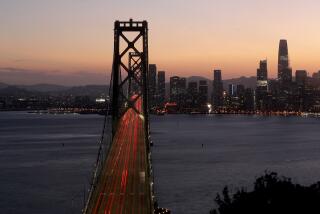L.A. all over again
WITH A SIZZLING economy growing 9% a year or more but facing limits on domestic energy, China has no choice but to seek more oil from foreign sources. Yet Americans were surprised when a Chinese company emerged as a serious contender to buy Unocal Corp. Then China was surprised by the ferocious political reaction among some U.S. conservatives, forcing China’s CNOOC Ltd. to withdraw its bid last week.
The astonishment on both sides shows that China and the U.S. are hardly prepared to relate to each other on 21st century terms. But as the expanding global economy continues to burden the global environment, each nation has much to gain or lose by studying the other’s energy failures.
China should look to the U.S. as it asks itself: If the price of growth is unbreathable air, undrinkable water, dysfunctional cities and congested roads, how long can a nation sustain a boom economy?
What China did learn from the United States is that a prosperous auto industry spawns growth in related industries, including steel, glass, plastics, oil, finance and insurance. What it seems not to have learned is the high price that can come with such growth.
In Beijing, where the number of cars is growing by 20% annually, the average traffic speed has declined from 28 mph in 1994 to 7.5 mph in 2003 — a pace easily matched on a bicycle. As in American cities, this rising level of car ownership has coincided with a sharp decline in transit ridership. Seventy percent of Beijing’s population used public transit in the 1970s. Just 24% use it today.
Commuters on bicycles, once ubiquitous on Chinese city streets, have been banned from major thoroughfares in Shanghai and other cities to make room for cars. As more Chinese drive, demand has risen for their version of California-style suburban sprawl, with immaculate low-density housing tracts featuring large detached single-family homes located far from jobs. Like Californians, Chinese commuters travel farther and spend more time on the road, requiring more gasoline and churning out more pollution. Clearly, California’s car culture and sprawl don’t provide the best model of sustainable development.
China should look to Curitiba in southern Brazil or Tokyo, which combine high rates of car ownership with low daily car use by offering good public transit and adopting tough restrictions on driving. You can buy as many cars as you want (and boost the car industry and the economy), but you don’t have to use a car for every trip.
China’s cities are not the only places under strain. China’s vast rural regions are attracting smokestack industries, dumps and other pollution sources the cities shun. Western news media recently have reported violent riots among villagers protesting pollution.
An estimated 15,000 protesters near Xinchang, 180 miles south of Shanghai, overturned police cars and threw rocks at authorities to vent anger over water pollution and unsafe working conditions involving dangerous chemicals used by a pharmaceutical factory. Fifty miles away, in Dongyang, an estimated 10,000 rioters rose up to demand closure of a pesticide factory.
With the human costs increasingly obvious, a surprising number of government officials, academics and others talk openly about the folly of China’s growth patterns. China’s Center for Sustainable Transportation is drafting recommendations to promote transportation that relies less on foreign oil. There is also hope in recent actions by the State Environmental Protection Agency. Long considered weak, the agency recently moved forcefully in cases involving high-profile construction projects supported by other Chinese government agencies.
China’s environmental challenges could become severe enough to impede economic growth. Now the world’s second-largest emitter of greenhouse gases, China is expected by 2025 to surpass the United States for the dubious title of No. 1, according to the Pew Center on Climate Change. The China Academy for Environmental Planning reports that air pollution-related illness accounts for 2% to 3% of gross domestic product and forecasts that by 2020, that figure will rise to 13%.
The U.S. should approach China not as a scold but as a partner, offering to help find innovative solutions. First, the U.S. could lead by example. The Bush administration’s refusal to join in the Kyoto Protocol on global warming, based in part on the treaty’s exemptions for China and other developing countries, sends the unflattering message that the U.S. protects its interests at the expense of the world environment. President Bush could ask Chinese President Hu Jintao to join him in working to reduce gasoline consumption and dependence on coal-fired electrical power plants in both countries, and to curtail other sources greenhouse gases.
U.S. businesses seeking to invest in China could influence conditions through their selection of products, business partners and vendors. For example, General Motors could take advantage of China’s lower production and marketing costs to develop new fuel-efficient vehicles. Once developed, those new vehicles also could be made in the U.S. for our consumers.
The Energy Foundation and the World Resources Institute’s EMBARQ project have supported trailblazing rapid-transit projects in Chinese cities similar to the MTA’s Metro Rapid bus lines in L.A. Now some farsighted Chinese officials want to go further, looking for help with the underlying causes of their energy and transportation woes, seeking ways to discourage car use and reduce commuting distances.
Instead of fighting over the world’s limited supply of nonrenewable energy, China and the U.S. should join forces to show the world a new model of prosperity — measured not only in dollars or yuan but in livable communities and a healthy environment.
More to Read
A cure for the common opinion
Get thought-provoking perspectives with our weekly newsletter.
You may occasionally receive promotional content from the Los Angeles Times.






